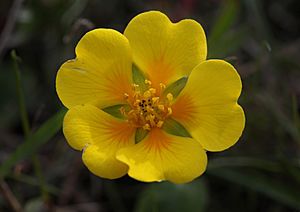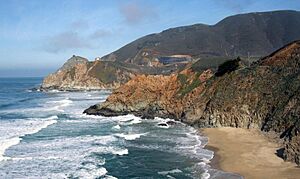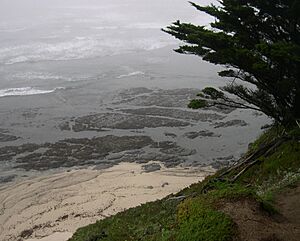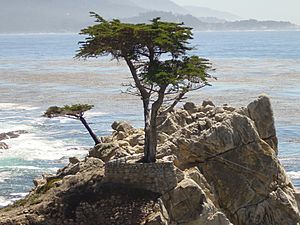Potentilla hickmanii facts for kids
Quick facts for kids Potentilla hickmanii |
|
|---|---|
 |
|
| Conservation status | |
| Scientific classification | |
| Genus: |
Potentilla
|
| Species: |
hickmanii
|
Potentilla hickmanii (also called Hickman's potentilla or Hickman's cinquefoil) is a rare wild plant. It is part of the rose family. This plant is endangered, meaning it is at risk of disappearing forever. It grows in only a few small areas in northern California, near the coast. You can find it in Monterey County and San Mateo County.
This small wildflower is special because it only grows in this specific part of the world. It produces bright yellow flowers from spring through summer.
Scientists once thought this plant also grew in Sonoma County. However, those plants were later identified as a different species. That specific group of plants is now thought to be gone from Sonoma County.
Many groups are working to protect Potentilla hickmanii. These include the U.S. government, the state of California, local governments, and private groups. They have created plans to help this plant survive. One important plan is called a recovery plan. The U.S. Fish and Wildlife Service created this plan.
Contents
What Does Hickman's Potentilla Look Like?

P. hickmanii is a plant that lives for many years. It has a thick main root, like a carrot. Its stems lie flat on the ground and can be 5 to 45 centimeters long.
The plant blooms with yellow flowers between April and August. Each flower has petals that are 6 to 11 millimeters long. A single plant can have up to 10 flower clusters.
The leaves of P. hickmanii are divided into smaller parts. They usually have six pairs of leaflets. These leaflets are small, only 2 to 8 millimeters long. They are shaped like a wedge and often have three or four small teeth or lobes. The plant's fruits are smooth, tan, and about 2 millimeters wide. They look like tiny watermelon seeds.
Where Does Hickman's Potentilla Live?
Today, P. hickmanii is found in two main coastal areas. One group of plants is on the Monterey Peninsula in the city of Monterey. Here, it grows in open grassy areas within Monterey pine forests.
People have tried to plant new colonies in Monterey County. For example, they tried at the Point Lobos State Reserve. But these attempts did not work. The new plants were taken over by European weeds. Also, some planting spots were too wet, or too hard to check on.
Another group of plants was found in Moss Beach, California, in 1933. This was in a wet area near San Vicente Creek. Sadly, this group was thought to be gone by the 1970s.
In 1995, another group was found in San Mateo County. This was on the slopes above Martini Creek near Montara Mountain. All the known groups of P. hickmanii grow between 10 and 135 meters above sea level.
This plant likes to live in native grasslands. It also grows under pine trees. The most important part of its home is the soil. It needs a special type of decomposed granite rock underneath the topsoil.
History of Discovery
The Monterey Peninsula is where P. hickmanii was first found. This area has a cool ocean climate. Even though it doesn't rain much, summer fog helps the plants get enough moisture.
Alice Eastwood discovered P. hickmanii in 1900. She was a botanist, a scientist who studies plants. She worked at the California Academy of Sciences in San Francisco. At that time, the Monterey Peninsula was a wild and remote place.
Alice Eastwood was exploring this area to find rare plants. She found a plant that no one had ever recorded before. She named it after J. B. Hickman, who was her guide on that trip. Hickman was also the horticultural commissioner for Monterey County.
Why Hickman's Potentilla Needs Our Help
In 1973, California listed Hickman's potentilla as an endangered species. In the 1990s, the U.S. government also started to protect it. This happened because new information about the plant came out. This information was part of reports for land development projects in Monterey.
In 1998, the U.S. Fish and Wildlife Service (FWS) officially listed P. hickmanii as endangered. This showed how important environmental studies are. They help us learn about species and protect them.
P. hickmanii is still in danger from new buildings and golf courses. These are being built as the human population grows. There are plans to protect the plant. But often, there isn't enough money to carry out these plans. This means the plant is still at risk.
The federal recovery plan asks for more studies of the plant. It also calls for surveys to count the plants. It suggests general protection and new plantings.
One good effort to help the plant is happening at the Fitzgerald Marine Reserve. Their plan is to improve the natural plants around Vicente Creek. This includes removing trash and harmful plants. This plan also helps protect the California red-legged frog, which is also endangered.
Monterey County, California has also made plans to protect P. hickmanii. The California Native Plant Society calls it "seriously endangered." This means it has very few groups of plants left.
The plants in San Mateo County are also in danger. They are being crowded out by invasive European weeds. These weeds grow tall and take over the area. Some of these weeds include Brachypodium, Vulpia, Holcus, and Briza species. Other weeds like Plantago and Phalaris aquatica|Harding grass are also a problem.
Harding grass is a very tall and strong weed. It can grow 2 meters high. It forms thick patches that can cover all native plants. This tiny 5-centimeter-tall P. hickmanii plant cannot survive without help. Each year, these weeds need to be cleared away from the P. hickmanii plants. This helps the native plants grow back.
Plant Counts and Status Updates
Scientists count the plants in each natural area where they grow.
- Monterey County, Indian Village, Pebble Beach: Between 1979 and 2008, the number of plants here changed a lot. It went from 5 to 35 plants. By 2011, the original plants were thought to be gone. Any plants left might be from seedlings grown in nurseries.
- Monterey County, Eastwood collection: The exact spot where Alice Eastwood found the plant is now lost.
- Monterey County, Pacific Grove: This group of plants was last seen in 1968. It is now thought to be gone.
- Monterey County, Point Lobos State Reserve: Experimental plantings here did not survive.
- San Mateo County, Montara Mountain: In 2008, eight groups of plants were found here.
- Group #1: 4 plants
- Group #2: 11 plants
- Group #3: about 1,060 plants
- Group #4: about 2,000 plants
- Group #5: 26 plants
- Group #6: 12 plants
- Group #7: 3 plants
- Group #8: 45 plants
By summer 2011, some of these groups were thought to be gone. This includes the largest group (#4), and groups #6, 7, and 8. They were buried under tall Harding grass. Group #3, which was once very large, had shrunk. Only about 300 plants were left.
- San Mateo County, Moss Beach: This group was last seen in 1933 and is now thought to be gone.
Some P. hickmanii plants might exist in nurseries or botanical gardens. But their numbers are not known.
Recent Observations (2013-2014)
It is hard to count these plants because they are small. Also, they flower for a long time, and the land is difficult to walk on. But surveys in 2013 showed that group #4 on Montara Mountain still exists. At least 500 plants were found there, growing above the Harding grass.
In 2014, people worked to remove weeds by hand. This greatly reduced the number of weeds. For example, big rattlesnake grass went from 61% cover in 2011 to only 1% in 2014. The hillside where group #4 grows was also mowed in summer 2014.
Images for kids
See also
 In Spanish: Potentilla hickmanii para niños
In Spanish: Potentilla hickmanii para niños





